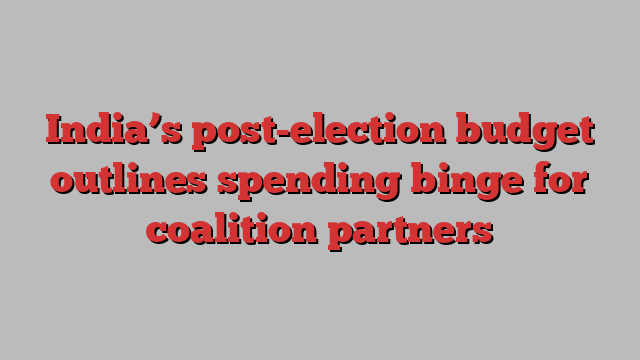
Unlock the Editor’s Digest for free
Roula Khalaf, Editor of the FT, selects her favourite stories in this weekly newsletter.
Indian Prime Minister Narendra Modi’s government has announced a spending splurge for its new coalition partners alongside job creation schemes in an effort to shore up public support following a shock election setback last month.
Modi’s Bharatiya Janata party was elected to a historic third term in June but lost its ruling majority, making it dependent on two regional parties to form a governing coalition.
In the new government’s first annual budget, for the year ended March 2025, finance minister Nirmala Sitharaman on Wednesday announced plans to keep capital investment at a record Rs11.11tn ($133bn) while trimming the fiscal deficit to 4.9 per cent of GDP, from its current 5.1 per cent target.
Sitharaman described India, the world’s fastest-growing large economy, as “the shining exception” to slowing global growth. The economy is estimated to expand between 6.5 per cent and 7 per cent this year.
Modi said the budget would “decide the direction for the next five years of our term [and] become a strong foundation of our dream of a Viksit Bharat [developed India]”.
Much of Sitharamana’s budget speech detailed billions of dollars worth of spending for the government’s coalition partners, the Telugu Desam party of southern Andhra Pradesh and Janata Dal (United) from Bihar in the north.
This included a Rs260bn industrial corridor running through Bihar, Rs150bn for a new “high-tech” capital in Andhra Pradesh called Amaravati and funds for flood reconstruction and developing local temples.
The government’s budgetary firepower was bolstered by a record Rs2.1tn transfer from the Reserve Bank of India, giving it room to continue spending while lowering its fiscal deficit target. Sitharaman said the government aimed to bring the deficit under 4.5 per cent the following year.
Andrew Holland, chief executive of Mumbai-based Avendus Capital Public Markets Alternate Strategies, said the budget was likely to “alleviate any worries about any coalition problems”.
“A lot of the RBI dividend has obviously gone towards rural development, jobs and Andhra Pradesh and Bihar,” he said.
The BJP also sought to mollify widespread public frustration that many analysts blamed for its electoral disappointment, announcing schemes to tackle youth joblessness and boost agricultural productivity for farmers.
Jairam Ramesh, a spokesperson for the opposition Indian National Congress, called the budget “far too late and . . . far too little”, adding that the government “seems to have finally come around to tacitly admitting that mass unemployment is a national crisis”.
India’s benchmark Nifty 50 index fell more than 1 per cent following the budget speech, after the government announced that it would raise the country’s short- and long-term capital gains tax. Yields on 10-year government bonds fell to a two-year low on plans to cut borrowing levels.
“The market will definitely have some knee-jerk reaction, but will definitely even out,” said Abhay Agarwal, founder and fund manager at Piper Serica in Mumbai. “More important [is] the focus of continuing to invest in infrastructure of all kinds.”
India, which last year became the world’s most populous country, has sought to capitalise on global investor interest in its economy as manufacturers and tech companies seek an alternative to China. It has attracted Apple to assemble iPhones in India, as well as a growing number of so-called global capability centres, in-house back offices for multinationals.
But its economy has been plagued by chronic weaknesses including low job creation, rising inequality and tepid private investment.
The budget “struck broadly the right notes on the important issues, such as the need to create employment which is a critical weakness”, said Montek Singh Ahluwalia, an economist and former deputy chair of India’s planning commission.
But he added that the success of programmes to address employment, agriculture and urban development “will all depend on how well the schemes are designed and how well they’re implemented”.
“We’ve had these schemes before,” he said.